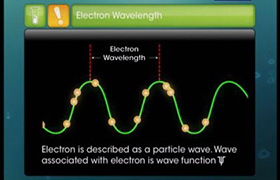CBSE Class 11-science Answered
What is principal quantum number, azimuthal quantum number & magnetic quantum number?
Asked by chinjalsoni911 | 16 Oct, 2018, 18:14: PM
Principle Quantum Number (n)
- The principle quantum number (n) is related to the size and energy of the main shell. “n” has positive integer values of 1, 2, 3,….
- The principal quantum number determines the size and to large extent the energy of the orbital. For hydrogen atom and hydrogen-like species (He+, Li2+.... etc.) energy and size of the orbital depends only on ‘n’.
- The principal quantum number also identifies the shell.
- All the orbitals of a given value of ‘n’ constitute a single shell of an atom and are often represented by the letters K, L, M, … For each ‘n’ value there is one main shell.

Azimuthal Quantum Number (l)
- The Azimuthal quantum number. ‘l’ is also known as orbital angular momentum or subsidiary quantum number.
- It defines the three-dimensional shape of the orbital.
- For a given value of n, l can have n values ranging from 0 to n – l, that is, ‘l’ has integer values from 0 to n- l for each value of ‘n’. Each ‘l’ value represents one sub-shell.
Each value of ‘l’ is related to the shape of a particular sub-shell in the space around the nucleus.
The Magnetic Quantum Number (ml)
- Magnetic orbital quantum number. ‘ ml ’ gives information about the spatial orientation of the orbital with respect to a standard set of co-ordinate axis.
- The magnetic quantum number (ml) has integer values between – l and l, including zero. Thus for a certain value of l, there are (2 l + 1) integer values of ml as follows:
ml = - l, (-l + 1)…, -1, 0, 1, …(+ l -1), + l
- When l = 0, (2 l + 1) = 1 and there is only one value of ml, thus we have only one orbital that is, 1s.
- When l = 1, (2 l + 1) = 3, that means ml has three values, namely, -1, 0, and 1 or three p orbitals, with different orientations along x, y, z-axes. These are called as px, py, pz.
Answered by Varsha | 17 Oct, 2018, 12:08: PM
Concept Videos
CBSE 11-science - Chemistry
Asked by o230397 | 23 Sep, 2023, 14:48: PM
CBSE 11-science - Chemistry
Asked by ks1221516 | 14 Nov, 2021, 18:46: PM
CBSE 11-science - Chemistry
Does shielding effect occur between atomic orbitals of the same quantum number? Explain with reasons
Asked by fishtailfever | 08 Sep, 2019, 23:00: PM
CBSE 11-science - Chemistry
Asked by patra04011965 | 09 Aug, 2019, 17:19: PM
CBSE 11-science - Chemistry
Asked by bhrjitu | 21 Jul, 2019, 08:08: AM
CBSE 11-science - Chemistry
Asked by pb_ckt | 06 Jun, 2019, 09:15: AM
CBSE 11-science - Chemistry
Asked by shahrithik07 | 18 Oct, 2018, 17:26: PM
CBSE 11-science - Chemistry
Asked by chinjalsoni911 | 16 Oct, 2018, 18:14: PM
CBSE 11-science - Chemistry
Asked by arunavamitra50 | 18 Jun, 2018, 18:39: PM
CBSE 11-science - Chemistry
Asked by badalsharma9929 | 13 Jun, 2018, 08:43: AM





